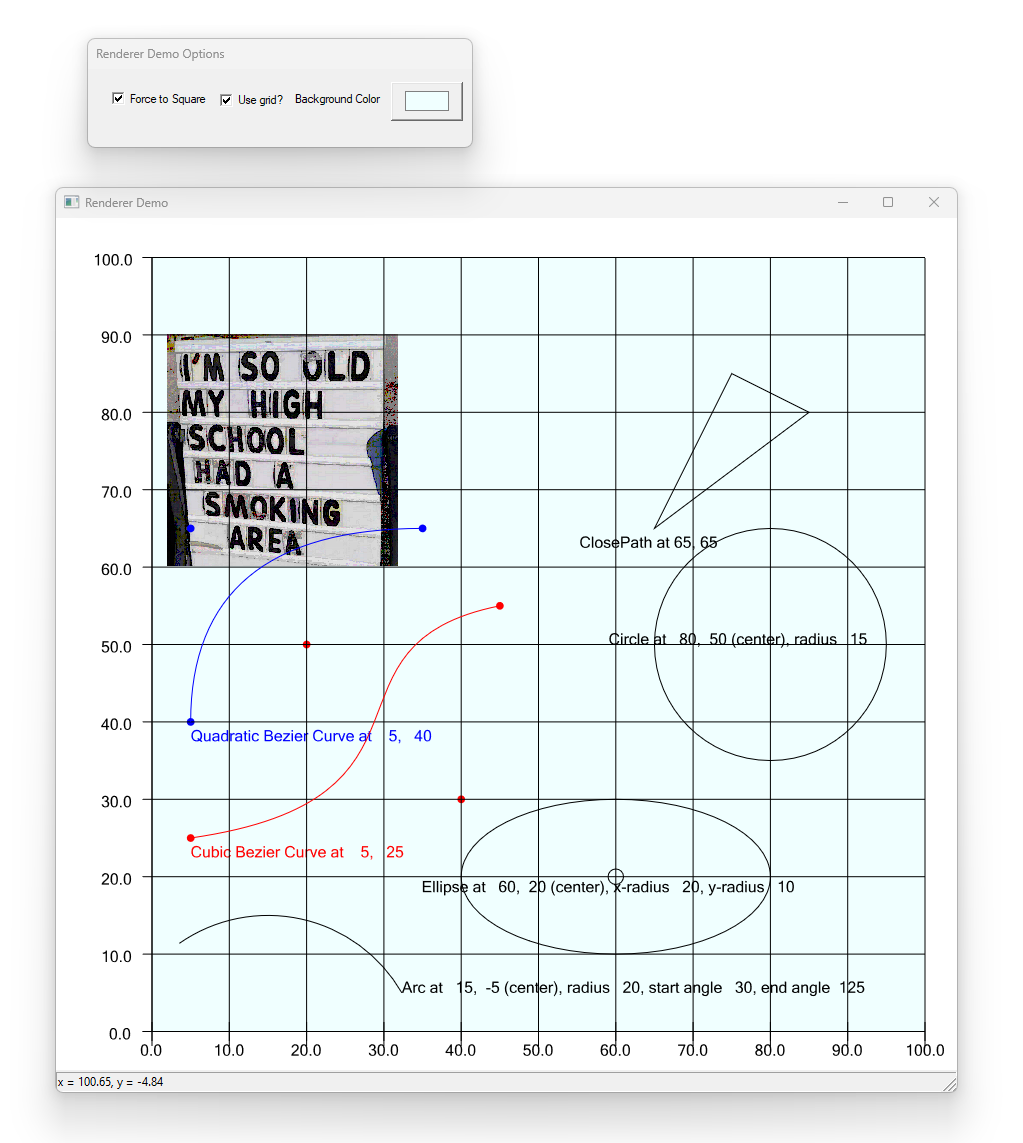How easy is it to use the Renderer ?
A Whole Lot of Easy !
The demo is the simplest of Windows applications. As a demonstration of the easiest way to create a windows application using the raw Windows API - the demo willtake the mysteries out of that.
The intent of the demo, though, is to show you how to embed the Renderer Object onto a window and begin drawing graphics on it right away. "Embed" is not really the right word, you'll see what I mean.
The demo is a simple Overlapped window, which is just a frame, a caption, and a client all rolled into one.
NOT a visual object !
What was that ?? This is not really a visual object ? Well, there's all of stuff in the image below that seems to counter that theory !
But let me explain, this object draws on your window! That is an important distinction. In other words this object does NOT create a surface (window and device context) of it's own. I have written a number of COM objects that use the OleObject, etc., family of COM interfaces in order to be used as an "embedded" visual object, and that can be just too complex to be any fun to use. It has it's place, but not here.
So, OLE/ActiveX, whatever it's called, is not the case here.
Indeed, there is no real connection between this object and any actual window in your software. The only connection is through a device context. And this can be any device context from any window in your system, OR to a printer, OR to a bitmap. yes, you can use this COM component simply to create bitmaps. Maybe it does not not even need be visual in your system. Maybe your system is a console application - no problem, this component is still 100% useful in this scenario.
Like I've said, this is a simple as possible, yet powerful and hopefully very useful in your projects.
A bit of history, skip if you want
This project actually came about as I was building my PostScript Interpreter project. Font handling in that project had been delegated to my Font Manager and that became a valuable product in it's own right.
But I struggled to find an understandable example of rasterizing fonts. I spent a few weeks with freetype, but ultimately I gave up and started looking for either a) a decent explanation and example of rasterizing theory, or b) a native implemenation built-in to the Windows API. I have no qualms using something from an Operating System - that is, after all, what Operating Systems are for, the more complete of them should expose those technologies that they obviously have within them for all of us to use.
Though it alluded me at first, I discovered that Direct2D can rasterize the fonts glyph contours I was producing perfectly, down to the smallest of sizes. Though this seems obvious, the API documentation steered me to DWrite - which I don't want. I'd already unraveled the incredibly complex world of fonts and glyph geometries, no way I would throw that away. So I marched onward.
I was getting really horrible rasterizing results at small sizes though for a long time. Finally I realized I had to upscale the glyph geometries while building up the graphics, and downscale them at rendering time. Presumable because of loss of precision by the use of FLOATs that the Direct2D world uses - a huge mistake in my opinion.
Direct2D without the lerning curve
So Direct2D became the perfect solution to getting excellent rasterization of my fonts. I realized at that point that I should create a universal graphics rendering engine for all graphics primitives. Not only for just font rasterization, but also for ALL PostScript drawing commands - of course independent of PostScript itself. Therefore, the EnVisioNatesSW_Renderer was born.
And it became one of the more powerful, and hopefully useful, of the three projects on this site - which include the PostScript Interpreter and Font Manager.
The following figure shows the demo in action.
When you build and run this demo, try resizing the big window.
Did you notice that the entire figure scales 100% automatically ?
Your not required to have it do this, maybe it's not in a resizable window, but achieving that effect is automatic and requires literally zero lines of code to accomplish.
Note one other thing, the window with the graphic on it is not owned or created by this COM object. As mentioned in the introduction above. That is far easier than having an embedded object, like an ActiveX Control. In the future I might make one but at this point it is so simple to "integrate" into your, or any, application, I don't want to muddy the waters.
